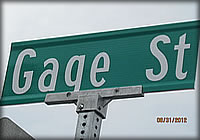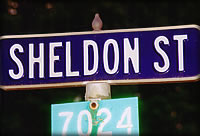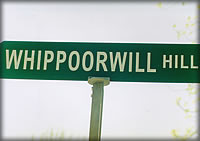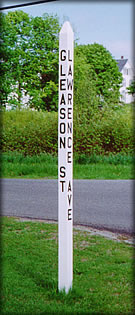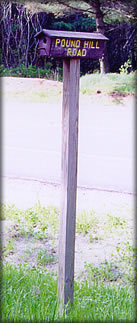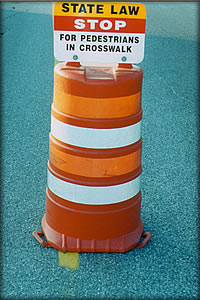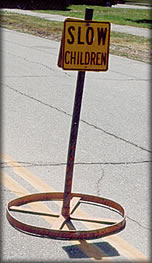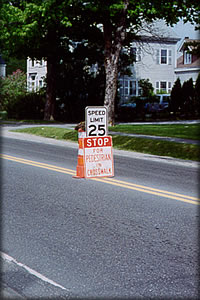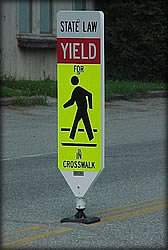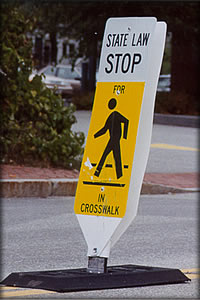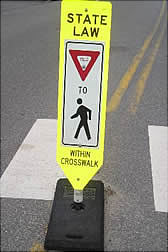Traffic Issues
All traffic-related controls on all Maine roads open to the public must follow the national "Manual on Uniform Traffic Control Devices" (MUTCD). This manual provides guidance for traffic signs, pavement markings, work zones, school areas, and much more.
MaineDOT also has extensive traffic information and data in its Traffic Engineering Division relative to traffic counts, crash records, permits, and official business signs. Another excellent resource is the National Center for Rural Road Safety.
- Speed Limits
- Traffic Ordinances
- Signs
- Striping
- Heavy Loads
- Traffic Counting
Speed Limit
Watch the “Setting Speed Limits on Maine Roads” video
For more information on MaineDOT’s updated speed limit setting process, please visit the 2024 Safety Initiatives Story Map
When establishing a speed limit, the main premise is that most drivers are prudent and will voluntarily comply with a reasonable speed limit. To determine what is reasonable, engineers use several criteria on a section of roadway to determine a proper speed limit. A properly set speed limit should represent the speed at which the majority of prudent drivers will be driving. The posted speed limit is rounded to the nearest 5 miles per hour.
Until recently, the primary focus was on the 85th percentile speed. That has changed to be a more context-focused approach where several other factors will determine the safest speed limit. The functionality of the road is very important. For instance, a two lane road near a school functions much differently than a multilane road through a commercial area. The same applies to rural areas vs urban areas and areas with bicycle or pedestrian users. Speed zoning is based upon several fundamental concepts deeply rooted in our American system of government and law:
- Driving behavior is an extension of social attitude, and most drivers respond in a safe and reasonable manner as demonstrated by their consistently favorable driving records.
- The normally careful and competent actions of a reasonable person should be considered legal.
- Laws are established for the protection of the public and the regulation of unreasonable behavior on the part of individuals.
- Laws cannot be effectively enforced without the consent and voluntary compliance of the public majority.
In Maine, state law (29-A � 2073 �-1 and 2075, �-3) authorizes the MaineDOT, with the approval of the Chief of the State Police, as the only legal entity to create or change a speed limit on a public way which includes, state and state aid highways and townways. On September 21, 2001, the law changed to allow certain “qualifying municipalities” to have the full responsibility and authority for setting speed limits on local roads if they choose that option. A “qualifying municipality” is one that (1) has a population over 2,500 as measured by the last US census, or (2) employs (not hires) a professional engineer (PE) licensed in Maine. Qualifying roads are ONLY townways which are federally classified as “local” roads. As of early 2024, there was not a single “qualifying municipality” that has chosen this option.
If a town creates or changes a speed limit or simply erects speed limit signs without going through the proper process, there is no legal authority to the change, and it is unenforceable. Except when conditions or other regulations require a lower speed, the following are maximum rates of speed:If a town creates or changes a speed limit or simply erects speed limit signs without going through the proper process, there is no legal authority to the change, and it is unenforceable.
Except when conditions or other regulations require a lower speed, the following are maximum rates of speed:
- 15 m.p.h. in a school zone at specific times of the day.
- 25 m.p.h. in a business or residential area or built-up portion, unless otherwise posted.
- 45 m.p.h. on all other public ways, unless otherwise posted.
- However, the noted 25 and 45 mph limits are usually unenforceable if they do not have MaineDOT approval
What about School Zone speed limits?
A “school zone” was also redefined in 2001 through LD 843 which became Public Law 2001, Chapter 145 and became effective on May 14, 2001. A “school zone” “means the portion of the public highway abutting improved school property or 300 feet on either side of a school entrance, whichever is greater.”
"Improved school property” is defined as “the developed portion of school property including driveways, parking lots, playgrounds, athletic fields or school buildings.”
The posted speed is in effect when school is in session, before school begins, after school, and at recess. Signs that say 15 MPH and “when children are present” should be removed because that was removed from state law many years ago.
Requesting a change in Speed Limit
If there are roads (state and local) in your town that the municipal officers feel a strong need to create or change a speed limit, a municipal official from the town must request the change in writing to your local MaineDOT regional traffic engineer. Due to many “No Change” speed studies, any request for a study must include a recommendation (from a municipal official or law enforcement) that the existing Speed Limit is unsafe. The Town Official should drive the roadway during off-peak hours, in good health and in free-flowing conditions. The request should communicate clearly that driving the roadway at, or slightly below, the existing Speed Limit feels, or is, unsafe.
It's important to understand that any resultant study may have the current speed limit go up, in addition to maybe going down, or remaining the same. A field study will be made and then a recommended speed will be forwarded to the MaineDOT Commissioner and the State Police. Then the town will be notified of the speed limit and will be responsible for erecting the standard and minimum 24" x 30" black-on-white signs in the proper locations if the change is on a town way. If the change is on a state road, then the MaineDOT will make the signing changes.
List of Regional Traffic Engineers
| MaineDOT Region | Location | Traffic Engineer | Telephone Number |
|---|---|---|---|
| Region 1 | Scarborough | Randy Illian | 207-885-7000 |
| Region 2 | Augusta | Darryl Belz | 207-624-8200 |
| Region 3 | Wilton | Tim Soucie | 207-562-4228 |
| Region 4 | Bangor | John Theriault | 207-941-4500 |
| Region 5 | Presque Isle | Ray DeMerchant | 207-764-2060 |
During the field study, there are several factors that engineers use to determine an acceptable speed limit.In fact, if your town is a “qualifying town” and chooses to set local speed limits, local officials should be studying the same factors.
- Geometric design of the road,
- Public and private access points,
- The number of intersections,
- The number of roadside businesses,
- Observed travel speeds of traffic,
- The observed speed ranges,
- Total accidents in recent years,
- A series of test runs on that section of road driving a certain speed, evaluating safety and drivability.
There are two types of speed limits: regulatory and advisory. A regulatory speed limit is set by MaineDOT and printed in black on a white background. The minimum size of regulatory speed limit signs is 24 X 30 inches.
The other type of speed limit is an advisory limit. This black-on-yellow speed limit sign is used to advise motorists of a comfortable speed at which to travel when different situations lie ahead. It is used with a warning sign like a right or left curve sign. The standard size for these signs is 18 by 18 inches, except in cases where it is 24 by 24 inches because it supplements a 36 inch and larger warning sign. Another type of advisory speed limit sign can be found in work zones. These signs are black on orange. These are used to advise drivers of construction ahead and provide work crews safety.
Traffic Ordinances (Municipal)
Question: 30-A MRSA 3009 grants the municipal officers the exclusive authority to adopt ordinances regulating the operation of vehicles in the public ways and on publicly owned property. What procedures should be followed to adopt such ordinances?
Answer: Assuming your municipality does not have any local charter provision providing a different process, the procedures which must be followed for the municipal officers to adopt traffic ordinances are set forth in 30-A MRSA 3009. The following is a suggested format for complying with those requirements:
- The municipal officers must cause a public notice to be posted at least seven days prior to the time of the meeting at which the traffic ordinance is to be considered for adoption and that notice must be posted in the same place as the town meeting warrant. If your town customarily posts in two or more places, the same number of postings would apply to these notices.
- The notice must give the date, the time, and the place of the municipal officers’ meeting.
- The notice should be directed to the voters of the municipality.
- The notice must contain in full the text of the proposed ordinance.
- The notice must be signed by at least a majority of the municipal officers, attested in the manner provided for town meeting warrants, and contain a return executed by the person who posted the notice.
- Example Ordinance Form ( PDF)
At the time of the meeting, the municipal officers should place the ordinance before the meeting for general discussion and by way of a statement explain the need for the ordinance. After that, the public should have the right to ask questions and engage in general discussion concerning the ordinance itself. After a satisfactory discussion period has been completed, the municipal officers should proceed with the consideration of the ordinance.
The enactment is not difficult. It may be accomplished by a motion made by one of the municipal officers, seconded by another, and voted upon by majority vote. Because there must be a record of the action, it is suggested that the town clerk be present, record the motion, record the second, and poll and record the individual votes of the municipal officers. The minutes of the town clerk plus a certified copy of the ordinance enacted should be record in the town’s records in the same manner as an action by a town meeting (By W.W.L.)
Once the ordinance is passed, the municipality must purchase the hardware and erect the signs following the standards established in the Manual of Uniform Traffic Control Devices (MUTCD).
Adapted from "Maine Townsman", November, 1983
Traffic Signs
“Let’s put a STOP Sign There And Slow Down Traffic” WRONG!
Many local and county officials are often pressured by constituents to put in STOP signs at intersections where the citizens of the neighborhood want to interrupt traffic, either by making the vehicles stop or by making it an inconvenience so that the traffic will use more expedient routes.This is a bad practice and will usually create more problems than they solve. In addition, if the municipality does not pass a traffic ordinance to authorize the placement of this regulatory device, the sign has no enforceability.
Studies from around the country show that there is a high incidence of intentional violations where the STOP signs are installed as a speed deterrent. These studies showed that the speed was reduced in the immediate vicinity of the sign but the speeds were actually higher between intersections than they would have been if the signs had not been there.
When installed correctly, a STOP sign will tell the driver and pedestrian who has the right of way.The Federal Highway Administration’s Manual on Uniform Traffic Control Devices contains criteria, which must be met in order to justify the installation of STOP signs as well as traffic control signals.Among other things, these criteria consider traffic speed, sight distance, traffic volume and the frequency of gaps that occur in the traffic that would allow for safe vehicle entry or pedestrian crossing.
Most drivers are reasonable, but when faced with unreasonable restrictions, may violate them and develop contempt for other traffic controls.Not only is this dangerous for the driver but for the responsible agency as well.Unwarranted or substandard traffic control devices contributing to an accident can sometimes be grounds to award a judgment against an agency involved in a lawsuit.
School Bus turnaround and STOP AHEAD signs, if justifiable and needed, can be erected on public ways. All signing on state or local roads must follow the criteria defined in MUTCD sections 7B.13 and 7B.14. It's important to understand that roadway bus signing may not make it any safer for buses or the travelling public. The best solution for a safe pickup area is to provide adequate sight distance for all vehicles. When one understands that these signs are usually visible 24/7/365 to all passing drivers and they are really only ‘needed’ for 1 minute or less during school pickup and dropoff times, their ultimate value is minimal at best.
Road signs give messages to drivers. If the messages are unclear, unnecessary, or confusing they can cause danger to motorists and others. Maine municipalities and the Maine Department of Transportation use the Manual on Uniform Traffic Control Devices (MUTCD) as the standard for placing traffic signs and markings to give clear messages to motorists.
According to the report "Maintenance Management of Street and Highways Signs" by the Transportation Research Board, improvements in traffic signing have the highest benefit-cost ratio of any highway safety improvement. About 29% of tort liability lawsuits against highway departments are related to traffic signing. For these reasons alone, it is worthwhile to install road signs according to the MUTCD.
Citizens often demand that the town erect "Children at Play" signs on their street to reduce the risk of automobile-pedestrian accidents. Selectmen ask: What does the MUTCD say about "Children at Play" signs? If we erect a sign on one street, won't we get requests from other neighborhoods in town to do the same? What's the town's liability?
The short answer is DO NOT ERECT "Children at Play" signs. The long answer is a bit more complicated:
- First, the "Children at Play" sign is unclear and unnecessary. It suggests to the driver that, if no such sign is present on another street, children are not playing there, and it is OK to speed or to be less careful. Another driver might interpret the sign to mean that children are playing in the road. Always? At what time of day?
- Second, it gives parents and children a false sense of security. By relying on the sign, parents might monitor their children less closely and children might interpret the sign to mean it is acceptable to play in the street.
- Third, one "Children at Play" sign leads to a proliferation of signs throughout the town. Since nearly every block has children living on it, there would have to be signs on each one. The effect of too many signs is that they become ineffective. The proliferation of signs breeds disrespect, not only for the specific signs, but for all signs.
- Fourth, to erect "Children at Play" signs in response to one request usually generates similar requests, thereby basing sign placement on politics rather than on sound traffic engineering judgment.
- Fifth, based on numerous studies, there is no evidence that "Children at Play" signs prevent injury or decrease the speed of vehicles.
- Sixth, because they are confusing and do not meet specific criteria for good signing, placing "Children at Play" signs opens the municipality to liability.
- Seventh, since all signs need to be maintained to be effective, the proliferation of unnecessary signs places an undue burden on maintenance crews. Purchasing, erecting and keeping these signs in good order is expensive.
For these reasons, the MUTCD discourages the use of "Children at Play" signs. However, municipalities can and should post signs for school zones, pedestrian crossings, and playgrounds. The MUTCD makes specific reference to these situations. Signing such areas gives clear messages to drivers about the kind of zone they are entering. "Children at Play" signs, on the other hand, do not meet a specific criteria.
Adapted from "Vermont Local Roads News"
Wisconsion Study
MMA's "Maine Townsman" article-Nov. 2008
JAKE BRAKE ADVISORY
from Maine Townsman, "Legal Notes," November 2008
For several years, and for several reasons, we've advised against the adoption of "Jake Brake" or engine braking ordinances as a means of controlling truck engine noise (see " Jake Brake' Ordinances," Maine Townsman, "Legal Notes," October 2000). Now we learn, courtesy of the MaineDOT's Maine Local Roads Center, that engine braking ordinances may actually be pre-empted by federal law.
The Noise Control Act of 1972 (now codified at 42 U.S.C. § 4917) authorizes the Environmental Protection Agency (EPA) to promulgate uniform national noise emission regulations for motor carriers engaged in interstate commerce. The federal statute expressly prohibits the states and their political subdivisions (including municipalities) from adopting or enforcing noise standards applicable to any motor carrier engaged in interstate commerce unless the standards are identical to the federal standards (see § 4917[c][1]). (The current version of the EPA's regulations is codified at 40 C.F.R. § 202.20.) Therefore, unless the noise standards in an engine braking ordinance are identical to the federal standards, the ordinance is unenforceable as applied to motor carriers engaged in interstate commerce.
As we've advised all along, engine braking ordinances can be difficult to enforce and may not get at the real problem, which is often a modified or defective exhaust system (which is already against State law, 29-A M.R.S.A. § 1912). The federal preemption of these ordinances as applied to motor carriers engaged in interstate commerce may be one more good reason to reject them.
Thanks to the Maine Local Roads Center (and its Vermont counterpart) for bringing this issue to our attention. (By R.P.F.)
Jake Brake Issues
- What they are and can a town control the truck engine noise?
- What they are and can a town control the truck engine noise? Many towns around Maine have started erecting “No Jake Brake” signs (or something similar) in hopes of “controlling” the engine noise from downshifting trucks Many residents are conscious of the noise and want the town “to do something” about the noise. Depending on your town and the cooperation of truckers, the results may be positive or they may be negligible.
- What is a Jake Brake?
-
What is a Jake Brake? "Jake Brake " is a registered trademark of Jacobs Vehicle SystemsTM. The term “Jake Brake” is sometimes incorrectly used to refer to compression release type engine brakes in general. The term correctly refers to all of Jacobs Vehicle Systems retarding products, including their line of Exhaust Brakes and Driveline Brakes. as well as Jacobs Engine Brakes. The Jacobs Engine Brake is a device that mounts on the engine overhead. The principle behind the Jacobs Engine BrakeTM engine retarder is simple. It changes the action of the exhaust valves, turning the engine into a giant air compressor. It makes a distinctive sound while in operation, and converts a power-producing diesel engine into a power-absorbing retarding mechanism. It is typically used on class 7 and 8 vehicles and can be activated or deactivated at the flip of a switch or foot on the pedal Further details can be seen on the company’s website:
When operating, it produces a distinctive staccato sound. When used on a vehicle with a poorly muffled or un-muffled exhaust (straight pipes for example), the sound can be quite loud.. which is what citizens will complain about. According to the Jacobs Company, the real problem here is the illegally modified or defective exhaust systems.
The signs around Maine are probably unfairly using the company trademark, because they are brand-specific. The term "Jake Brake" also refers to the company’s nearly silent exhaust brakes and driveline brakes, so these signs don't make sense for all Jake Brakes.. and don't target the root problem of illegal exhaust systems Therefore, any sign or ordinance should avoid use of the term “jake brake”.
-
- What are the benefits of using a “jake brake”?
-
A “jake brake” can provide:
- Faster, steadier, more efficient braking performance.
- Reduced wear on engine, tires, and service brakes.
- Lower vehicle maintenance costs.
- Less vehicle downtime.
- Enhanced driver confidence.
-
- Can our town pass an ordinance to “control” the noise?
-
Can our town pass an ordinance to “control” the noise? First of all, erecting a sign or two without an ordinance has no legal authority As with any regulatory traffic issue, a traffic ordinance must be in place to “enforce” the actual signs, or the sign is advisory only.Enacting a traffic ordinance to deal with “jake brakes” under 30-A § 3009 may seem like a kind and responsive reaction to engine noise, but is safety of the public being compromised?? Engine brakes are very effective at reducing the speed of heavy trucks on a downgrade, but what if the trucker had to stop quickly for a child or elderly person or an entering vehicle, and only use his regular brakes?? In most cases, the stopping distance will be longer without the engine braking system and this could lead to disaster at the bottom of the hill.
At best, the success of an ordinance will probably be voluntary compliance from truckers Some truckers may be sensitive to their truck noise and will try to reduce the noise, while others may intentionally try to make it worse, especially if a “squeaky wheel” citizen is emphatic about the noise problem. If a town passes a specific "jake brake ordinance", is the “No Jake Brake” sign or “Quiet Zone” sign a black lettering-on-white regulatory type sign.... or is it (wrongly) on a black-on-yellow warning sign?? If the local police get into the action of enforcement, are they going to check the actual engine braking system installed on each truck, or have a decibel meter to measure the noise level? What if the trucker says he had to stop quickly for a pedestrian? Or the car in front of him stopped quickly?
-
- What is the real problem?
- The federal government has required all vehicles manufactured since 1978 to meet noise requirements when delivered to the customer. Today, trucks are required to emit less than 80 dBa of noise when they drive by, as measured at 50 feet. So trucks have been required to meet noise requirements when they leave the dealership as new vehicles for quite some time. In many “noisy truck” areas, the real problem is modified or defective exhaust systems. There is a good chance that the noisy trucks are running with straight stacks or gutted mufflers. Some are poorly maintained vehicles, while others have drivers who simply enjoy making noise. In any case, the use of the engine brake may not be the problem. The real problem in this noise issue is the illegal exhaust systems in many trucks At other times, it may be the engine braking system, which is being used by the driver who has not tried to slow down in advance of a hill or traffic signal. The regulations on vehicle noise relating to engine/muffler systems need to be enforced Otherwise, atown would be fining for using engine brakes (sometimes being used justifiably) and not fining for the illegal muffler system
- What can a town do?
-
Most states, including Maine, already have a law on the books that prohibits operating a motor vehicle on a public highway without a serviceable muffler (MRSA 29-A§ 1912). The real noise offenders, those with straight stacks or gutted mufflers, are operating in violation of this law. Have your local police stop noisy vehicles and check them for muffler integrity. Cite those that are not in compliance. This is a fairly easy step that should produce a noticeable improvement in the quality of life of your community.
If the town decides to enact a traffic ordinance under 30-A § 3009, it probably is best to hope for voluntary compliance, but who will do the enforcement? Another ordinance without enforcement possibilities is relatively useless Be sure to use the black-on-white signs and try to avoid the term “jake brake”. maybe use “quiet zone ahead”, or “reduce engine noise ahead”.
If a town does not adopt an ordinance and simply puts up a sign or two, the signs have no legal authority or enforceability.
-
- The MaineDOT response
- The MaineDOT will not erect these signs on state roads The only way that a sign will appear is if a town officially adopts an ordinance and erects the signs themselves Then the town will be responsible for enforcement, sign maintenance, or any liability issues
Reviewed and edited by MMA Legal Division (October, 2000)
MUTCD Compliance Date Rulemaking
As of May, 2012, the FHWA completed its review of nationwide public comments relative to certain deadlines for sign reflectivity for all types of roadway signs. Their review is detailed in a Federal Register dated May 14, 2012 and can be found here: http://mutcd.fhwa.dot.gov/. The effective date of their ruling was June 13, 2012.
Essentially, they changed the target dates for certain traffic control devices, including street name signs, and reduced the impacts of these dates on state and local agencies. They eliminated compliance dates for 46 items and extended or revised 4 more items. A couple of the eliminated dates related to sign reflectivity and deadlines to meet those conditions. More details can be found here: http://safety.fhwa.dot.gov/roadway_dept/night_visib/signreg.cfm.
Even more info can be found here, especially on nighttime visibility of different devices: http://safety.fhwa.dot.gov/roadway_dept/night_visib/.
Prior to this 2012 ruling, the National MUTCD, which is the standard for all roads open to public travel in Maine and every state, had some important dates of January 2012, 2015, and 2018 that spoke about having a state or local sign management plan plus some replacement dates for specific signs. That has now been simplified and replaced with this May 2012 information. The details are now incorporated in the online version of the 2009 MUTCD http://mutcd.fhwa.dot.gov/kno_2009r1r2.htm and specific details can be found in Table I-2 in the Introduction, and Table 2A-3 in Section 2A.08.
For Maine towns and cities, it’s important to understand that compliance with this standard is achieved by having an assessment or management method in place by June 14, 2014 even though some individual signs do not meet the minimum levels at a certain point in time. The Center is now working on some sign inventory software for municipal use to help towns/cities meet this requirement.
The MaineDOT Traffic Division has chosen the Management Method entitled “expected sign life”. Typically this means that individual signs are labelled to mark the date of fabrication or installation.
Pamphlet on Sign Assessment and Management Methods.
The use of bright yellow-green fluorescent warning signs is permissible for certains signs on public roads in Maine. Up to this time, national standards, as described in the Manual on Uniform Traffic Control Devices
(MUTCD), only allowed the use of yellow as the background color for permanent warning signs such as curve
signs, pedestrian signs, school zone signs, etc.
The 2003 MUTCD includes the optional use of these fluorescent signs for pedestrian, bicycle, and school applications. Specifically, the allowable signs include the following:
- Pedestrian W arning (W11-2)
- Bicycle W arning (W11-1)
- School Advance W arning Sign (S1-1)
- "School" Plaque (S4-3)
- School Bus Stop Ahead (S3-1)
- Playground W arning (W15-1)
- In-Street Pedestrian Crossing Signs (R1-6)
No other applications are allowed for the use of this very bright color. The intent of this unique color is to increase the driving public's awareness of crosswalks, schools, and bicycle areas. If the color was allowed for other "regular" warning applications, the color would grow "old" very fast and would not command as much attention.Limiting this color to these particular signs will hopefully make them more noticeable to the driving public.
The initial cost of purchasing one or more of these signs is more than a conventional engineering grade sheeting. A town which decides to erect some of these bright signs at certain areas in town will pay a higher initial price for the fluorescence. The payoff is a sign which has been shown to be more visible and which may result in better motorist recognition, thus reducing vehicular-pedestrian conflicts.
It's worth trying some of these signs if your town has a typical pedestrian/vehicle conflict on some of its roads. This color has been received positively as an accepted and innovative tool to provide for increased pedestrian safety.
Most towns throughout Maine are finished with their E-911 process and have invested in and erected new street name signs. Recent changes on the federal level have raised a few questions about sign color, size, and reflectivity. How will this affect Maine towns and cities?
Consider the following factors:
- The driving population is getting older
- Older drivers have only 65 % to 77% of the legibility distance of younger drivers at night
- Drivers of ambulances, fire trucks & police cars depend on highly visible signs especially when it's foggy or snowy, especially if they have to cover a large territory and many towns
- Tourists rely on signs for guidance to hotels, homes, etc
- other drivers, including UPS and Federal Express drivers depend on good street sign
Examples of old and new signs
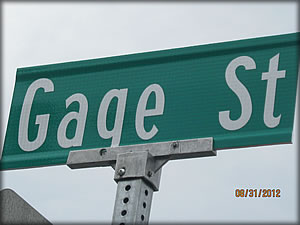
Recommended standard for new or replacement signs after 2012
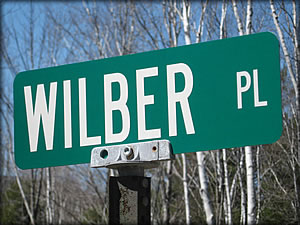
Former standard
New Standards call for Sign changes during replacements
The national Manual on Uniform Traffic Control Devices (MUTCD) governs the design and placement of all signs on roads that are open to the public.
There are several varieties of signs that are available for
public
road use. The most suitable is the green background with reflective white lettering. It is important to insure that letters are tall enough and thick enough to be easily seen day or night. Proper mounting height is
also very important.
Listed below are the recommended standards concerning the size, placement, materials, colors, and lettering for road signs. They are based on the MUTCD, which is the national standard for all public agencies, including municipalities, the Maine DOT, and the Federal Highway Administration.
Size
- Changes to the MUTCD in 2012 list a new recommended size for lettering on any new (or replacement) road name signs. Existing signs can remain “as-is” until there is a need to replace them in the future.
- The lettering for names of streets and highways shall be composed of a combination of lower-case letters with initial upper-case letters, such as “Main St” rather than “MAIN ST”. As of June 2012, the MUTCD recommends that initial upper-case letters be at least 6 inches in height and lower-case letters be at least 4.5 inches in height.
- Supplementary lettering (such as St, Ave, Ln, or Rd) or the section of the city (such as NW) may be in smaller lettering, composed of initial upper-case letters at least 3 inches in height and lower-case letters at least 2.25 inches in height.
- For local roads with speed limits of 25 mph or less, the lettering on post-mounted Street Name signs may be composed of initial upper-case letters at least 4 inches in height and lower-case letters at least 3 inches in height.
- On multi-lane streets with speed limits greater than 40 mph, the lettering on post-mounted Street Name signs should be composed of initial upper-case letters at least 8 inches in height and lower-case letters at least 6 inches in height.
- If overhead signs are used, the lettering should be composed of initial upper-case letters at least 12 inches in height and lower-case letters at least 9 inches in height.
- Typical blade heights are 6 and 9 inches. Blade lengths can vary with the names but longer signs can become unstable if not built with the proper material or thickness.
Placement
- In business or commercial areas and on principal arterials, signs should be placed at least on diagonally opposite corners. In residential areas, at least one Street Name sign should be mounted at each intersection. Signs naming both streets should be installed at each intersection. They should be mounted with their faces parallel to the streets they name.
- The preferred mounting method for road signs is post top-mounting brackets. Hardware for mounting signs to posts can vary but an agency should choose the more durable product to minimize vandalism and the ease of removal.
- In rural areas, the minimum height, measured vertically from the bottom of the sign to the elevation of the near edge of the pavement, of signs installed at the side of the road shall be 5 feet.
- In business, commercial, or residential areas where parking or pedestrian movements are likely to occur, the minimum height, measured vertically from the bottom of the sign to the top of the curb, or to the elevation of the near edge of the traveled way, of signs installed at the side of the road or where the view of the sign might be obstructed, shall be 7 feet.
- To optimize visibility, Street Name signs may be mounted overhead.
- Road name signs can be mounted on top of another sign, such as a STOP sign as long as the visibility of the two signs, especially the STOP sign, is not compromised.
Colors
Street Name sign shall be retroreflective, or illuminated, to show the same shape and similar color both day and night. The color of the legend (and border, if used) shall contrast with the background color of the sign which is normally green. The only acceptable alternative background colors shall be blue, brown, or white. Regardless of whether green, blue, or brown is used as the background color for Street Name (D3-1 or D3-1a) signs, the legend (and border, if used) shall be white.
For Street Name signs that use a white background, the legend (and border, if used) shall be black. An alternative background color, other than the normal green, may be used when the town wants to distinguish between public vs private roads. Retroreflective sheeting should be high intensity prismatic or better.
Lettering
All word messages shall use standard wording and letters as shown in the MUTCD and in the "Standard Highway Signs and Markings" book.
Materials
The most commonly used material for blades is either extruded aluminum with a 0.25 inch flange edge thickness and a 0.063 to 0.08 inch web (min.) or flat sheet aluminum with a minimum thickness of 0.08 inches (6 in. blade) to 0.125 inches (9 in. blade). Other materials, such as fiberglass or wood can be used, if they achieve the same level of visibility, durability, and reflectivity but that can be difficult to impossible to achieve compared to aluminum. On lower speed roadways in federally-recognized historic districts, historic street name signs may be used without complying with many of these provisions such as color, letter size and reflectivity.
Dig-Safe
Calling Dig-Safe is also a MUST before you install posts in new locations. In fact, it is a State Law. Driving posts is technically "excavation", with the possibility of damaging underground cables or utility lines. It may seem like overkill, but calling a free 888-number with the exact locations of all your posts is really not a difficult task. Damaging a fiber optic cable which "I knew wasn't there" can create major headaches for everyone and cost you a lot of money. For more info, see www.digsafe.com
Can a Town Legally erect Street Name Signs on Private Property for E-911?
Maine Municipal Association recently provided the following information to guide towns who would like to post road signs on privately owned roads:
- Ordinarily, it is unconstitutional for towns to expend public funds for private property, BUT, towns can expend public funds for signs to post on private property for public safety reasons.
- In order for towns to install signs on private property, they must first get permission from the landowner, unless the sign is being posted on the public right-of-way or easement.
- It is recommended that land owner permission be granted in the form of an easement because verbal permission can be revoked at any time. A letter granting permission would be second best.
- If a town were to install a sign on a private road without permission, the owner could legally remove it.
- If a person removes a sign on a public right-of-way, it is a criminal offense. In addition, the town can recover costs in a civil suit against the perpetrator.
- Towns are not under any obligation to post signs on a public or private way. The Emergency Services Communication Bureau (E-911 office) strongly recommends that, in the interest of public safety, towns do post signs on ALL roads. In many, many places, that sign is the only identifying object to the responding ambulance or policeman.
- Often residents of private roads are concerned that having a road sign will encourage more traffic. "Some towns differentiate between public and private roads by signing public roads with green signs and private
roads with blue or red signs," explained Stephan M. Bunker, E9-1-1 Director (former). "Other towns add a small sign with the ‘PVT" on it to designate a private road."
Adapted with permission from MMA, Sept. 1997
New standard for all new and replacement signs as of June 2012 with proper size, color, retro-reflectivity, and letter sizes. |
A Street sign in good condition with properly sized letters, and correct usage of color contrast as recommended by the MUTCD (white on Green). As of June 2012, when this is replaced, the letters need to look
like “James” and not “JAMES”. |
Marginal sign because it has no reflectivity for nighttime visibility and it is bent with chipped paint. While the MUTCD recommends white-on-green for contrasting colors, black-on-white is acceptable too. When this sign is replaced, it needs to be retro-reflective and say “Central” and not “CENTRAL”. |
Not recommended. It's distinctive but lettering is too small and sign is non reflective |
Marginal sign because it has no reflectivity for nighttime visibility. While the MUTCD recommends white-on-green for contrasting colors, white-on-blue is acceptable too. When this sign is replaced, it needs to
say “Sheldon” and not “SHELDON”. |
Good sign but lettering is only 2" tall when it should be minimum 4" tall. |
A sign in poor condition. No reflectivity, but does it use contrasting colors. However, the MUTCD recommends using white lettering on a green background. Plus, E-911 standards discourage "FR" (Fire Road) signs, because you would have addresses such as 24 Fire Rd. 42 or 42 Fire Rd. 24. |
This is not a recommended standard in the MUTCD. It has vertical lettering (which may be buried in the snow), a wooden post, non-reflective paint and black on white lettering instead of white on green lettering. It is also "unnatural" for human eyes to read vertically. |
Quaint idea and provides refuge for birds, but is NOT recommended for street name signs. |
There are many of these devices on Maine roads. Some are on state roads and others are on local roads. This is the MaineDOT's position and policy regarding the use of in-street devices to alert motorists to the potential presence of pedestrians in marked crosswalks. These devices are specifically for unsignalized pedestrian crossings where there is a marked crosswalk. The Manual on Uniform Traffic Control Devices (MUTCD) is the official guide for the installation and use of traffic control devices on all Maine highways. The latest version of this document was published in December, 2009 and it addresses the use of in-street devices at crosswalks in Sections 2B-12 and 7B-12.
The MaineDOT does not support an independent development of another standard or the use of "nonstandard" devices sold by vendors. As a practical matter, if you have any one of a variety of these devices now in your town/city, then it is recommended to replace these devices with this new standard. Maine DOT has generally not objected to these devices being placed in marked crosswalks on State roads at the discretion of the local municipality.
Consideration should be given to the overall width of the street, the existence of parking, and ability of the motorists to recognize that a crosswalk exists and potential liability. In addition, does the device create a sense of false security to pedestrians who "feel" more protection from one of these devices and proceed with less caution across the crosswalk? Also, it's important to understand that if the State is restriping the centerline near these devices, the striping truck will probably turn off the paint guns, drive around this device and resume striping on the other side, especially if they are bolted into the pavement.
If a device is placed in the road, it must not encumber the movement of vehicles along the street. That is, it should be a flexible vertical panel which does not encroach into the normal travel lane and it must bounce back to its normal vertical position when struck by a vehicle. It should also not be placed directly in the crosswalk to hinder pedestrians. Any sign shall not be post-mounted on the left or right side of the road. The message/device must be reflectorized if it is to be left in place during night time hours and it must not have metal signs or heavy weighting devices such as concrete blocks or sandbags. It must use the word "YIELD" and not "STOP" to be consistent with Maine law.
MaineDOT recognizes that pedestrian concerns are an important issue to many communities throughout the State. The Department has also accepted the fact that the use of these in-street devices has apparently had a positive effect on driver behavior and awareness of pedestrian needs. Although State law (23 § 1351) states that "all traffic control devices, erected by towns, on state and state aid highways shall be subject to approval of the Department", MaineDOT has not prohibited their use in those locations which have been determined by local agencies to meet the criteria for installation.
It's also very important to realize that municipalities are subject to the so- called "highway defect law" (23§ 3651-3655) and these devices may create some liability issues if injury or property damage results due to the presence of these devices. Also, it's important to realize that if you ultimately decide to allow the first device on a road, many more requests may follow. Does the Town have good justification for allowing some, but not others, and does it have $200+ to pay for each device?
Sign Examples
Too big with metal sign |
Dangerous |
Big barrel with metal signs& sandbag on top not good |
Better because the message says “YIELD |
Better,but State law Says “YIELD”.not "STOP" |
Proper device |
2019 - Logix SafePlace 650

This video series offers an overview on owning and operating Traffic Logix's speed feedback radar sign, model SafePace 650. This series has been split up into four videos:
- Video 1: Safely unboxing the sign
- Video 2: Mounting and assembly of the sign
- Video 3: Connecting your computer to the sign
- Video 4: Navigating the software and downloading the data
For the most up-to-date information please contact Traffic Logix directly.
Special thanks to MaineDOT's ITS Engineers Colby Fortier-Brown, Luke Lorrimer, and Maine Local Roads Center. Video produced by MaineDOT Office of Creative Services.
Road Striping
Pavement markings are painted centerlines, edge lines, crosswalks and special messages. Markings have definite and important functions in traffic control. Sometimes they supplement the regulations or warnings of other traffic control devices. Used alone they can produce results that other devices can't, effectively designating a lane, locating the road center, and locating a stopping point, information that could not otherwise be made understandable. Pavement markings have limitations. They are obliterated by snow, may not be clearly visible when wet, and may not be very durable under heavy traffic. It may be necessary to repaint them every year, or more often. Despite these limitations, pavement markings are still used because of their unique advantage: they convey information to drivers without diverting their attention from the road.
General Principles
All pavement markings should conform to several general principles:- Yellow lines separate traffic flowing in opposite directions or mark the left edge of the pavement on one-way roadways.
- White lines separate traffic flowing in the same direction or mark the right edge of the pavement.
- Line width indicates the degree of emphasis. Normal center lines and edge lines are four inches wide. A wide line is at least twice the width of a normal line.
- Double lines, two normal width lines separated by a discernible space, indicate maximum restrictions.
- A broken line is formed by segments and gaps, usually in the ratio of one to three. A recommended standard on rural roads is ten foot segments followed by 30 foot gaps.
- The MUTCD does NOT allow the use of a single yellow or white centerline on a two-lane two-way roadway. It does, however, have minimum thresholds under which a centerline may not be needed.
- When resurfacing a road which has an existing centerline, a centerline should be provided on the new surface to reduce possible liability, since people have become accustomed to and expect a centerline.
- When a centerline is used, all no passing zones must be marked with a double line of two normal solid yellow lines.
- The MUTCD and/or traffic engineering personnel should be consulted regarding the markings of passing and no-passing zones.
- Particularly useful during bad weather and poor visibility conditions.
- Break edge lines for intersections, but do not break them for driveways.
- Solid white line for right hand edge. Solid yellow line for left edge of a one-way roadway, divided street or highway.
- Solid white lines normally 12 to 24 inches wide.
- Stop lines emphasize the stop condition and indicate where to stop.
- Should ordinarily be placed 4 feet in advance of and parallel to the nearest crosswalk line. In the absence of a marked crosswalk, the stop line should be placed at the desired stopping point, in no case more than 30 feet or less than 4 feet from the nearest edge of the intersecting roadway.
- Should be placed in line with the STOP sign. However, if the sign can not be placed exactly where vehicles are expected to stop, the stop line should be placed at the stopping point.
- MaineDOT Crosswalk Policy (PDF)
- On roads where traffic is not controlled by signals or stop signs, crosswalk markings warn the motorist of a pedestrian crossing point.
- On controlled intersections, crosswalk markings primarily guide pedestrians in the proper paths.
- Do NOT use crosswalk markings indiscriminately. Only an engineering study should recommend installing crosswalks where there are no traffic signals or stop signs.
- Crosswalk lines shall be:
- Two parallel solid white lines spaced not less than six feet apart.
- Solid white lines shall be a minimum of 6 inches wide and may be up to 24 inches wide in certain circumstances.
- Crosswalk lines on both sides should be extended the entire width of the pavement.
- For added visibility, the area inside the crosswalk may be marked with white diagonal lines at a 45 degree angle or with white longitudinal lines at a 90 degree angle to the edge lines of the crosswalk. These lines should be about 12 to 24 inches wide and spaced 12 to 24 inches apart.
- When diagonal lines are used to mark a crosswalk, the transverse lines may be omitted. This type of "piano key" design is intended for use where many pedestrians cross without any other type of traffic control device.
- Non-conforming designs and colors should be avoided.
- Advance crossing signs should be used when the crosswalk is not obvious or in high traffic volume situations, to alert drivers of unexpected pedestrian entries into the crosswalk.
Heavy Loads
Heavy loads can cause significant damage to our state's highway and bridge infrastructure. A 16 minute video was produced recently for municipal officials that explains the importance of posting and the correct steps and practical aspects of restricting vehicles. It has been endorsed by MMA and the State Police. In addition, here is a link to two streaming videos that illustrate the impact of loads on roads. Although they were produced in Minnesota and South Dakota, they pertain to Maine as well.
Under authority of Maine law Title 29-A § 2395, all public roads may be temporarily posted to prevent abuse by heavy vehicles. The statute states that all municipal officers (not officials), the MaineDOT, and county
commissioners "may restrict the weight or passage of any vehicle over any way when, in its judgment, such passage would be unsafe or likely to cause excessive damage to the way or bridge." The MaineDOT"may adopt rules to
ensure proper use and prevent abuse of the public ways under the department's jurisdiction whenever those ways require special protection...". County commissioners and municipal officers may impose restrictions within
their
respective jurisdictions similar to those made by the DOT. Many of Maine's local roads are not capable of handling today's heavier vehicle loads even during the summer and fall, so it may be advisable to post roads during
these "other" seasons, if necessary. MaineDOT Rules allow posted rules on state roads during any time between November 15 and June 1. The MaineDOT Posted Road page has an interactive map of state-posted roads, and a list of local roads posted by towns/cities/counties.
State
Rule 308 SEASONAL LOAD RESTRICTIONS ON STATE ROADS (Word)
Maine law was changed in the Fall of 2000 and Spring of 2017 respectively for the benefit of home heating fuel delivery trucks and carriers of organic animal bedding. The law now reads that "any vehicle delivering home heating fuel or organic animal bedding and operating in accordance with a permit issued by the Department of Transportation... may travel over any county or townway without a specific municipal or county permit." In other words, if one of these fuel trucks has a DOT permit, then it is good for travel on State roads and townways. This allows fuel truck drivers to get only one DOT permit and not one from every town which it may be traveling in. These revisions also state that a municipality may continue to "impose additional restrictions for a vehicle delivering home heating fuel or organic animal bedding to operate on public ways within that municipality but may not require a permit to operate according to those restrictions." In other words, 1) these trucks carrying these two specific products must obey local regs which may be stricter, and, 2) restrictions and/or permits can still apply to trucks carrying other commodities on local roads.
How does a Town "impose restrictions"?
Per 29-A M.R.S.A. § 2395, the municipal officers
(Board of Selectmen or Town/City Council) may "impose restrictions" similar to rules developed by
MaineDOT. It is best to develop a set of local rules and regulations in the form of a "traffic ordinance", per 30-A § 3009, because the term "ordinance" is more familiar to courts and to law enforcement officers. If
your municipality wishes to adopt the sample ordinance from the Maine Municipal Association, as of 2017, it no longer directly refers to MaineDOT rules and regulations in that ordinance. No matter what they are called,
these regulations should be adopted only at a public meeting of the Board; public notice of the meeting, given at least 7 days in advance, and a copy of the proposed regulations should be posted in all the places where
town meeting warrants are usually posted. Once adopted by the Board/Council, the ordinance must be kept on file and should be posted in the Town Office/City Hall or on the website. Please note that voter approval is
not necessary.
Once the restrictions are established, it is good business to inform local residents, contractors, suppliers, etc. before you actually post your roads. The best procedure is to put a notice in
the local newspaper(s) several days in advance stating which roads will be closed and during which time period. The main idea is to enact rules which are related to the registered gross vehicle weight. This eliminates the
need to actually weigh vehicles --- simply check the registrations. If you do not specify registered weight in your rules, then actually weighing vehicles is a requirement if you want to prosecute violators.
It is probably easiest to develop local rules which follow the format of the Maine Municipal Association which has a "model ordinance" available. This "model" could be very helpful in developing your local
regulations.
MMA Model ordinance (Word) (PDF) Updated February 2018
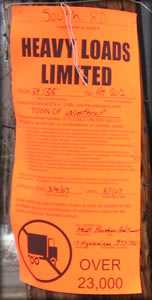 The main idea is to enact rules which are related to the registered gross vehicle weight. This eliminates
the
need to actually weigh vehicles-simply check the registrations. If you do not specify registered weight in your rules, then actually weighing vehicles is a requirement if you want to prosecute violators.
The main idea is to enact rules which are related to the registered gross vehicle weight. This eliminates
the
need to actually weigh vehicles-simply check the registrations. If you do not specify registered weight in your rules, then actually weighing vehicles is a requirement if you want to prosecute violators.
In Maine, there is a large variation in weather from south to north and road conditions can vary dramatically. Whether it's in the "January thaw" or later in the winter and early spring, the top road layers begin thawing and can't drain excess water which makes the road highly susceptible to damage. To reduce roadway damage, the MaineDOT and many towns apply spring load restrictions ( or "post" the roads) during the critical time interval when the pavement is most vulnerable to damage. That is usually when temps starting getting above 32 F. However, there is now a very handy technical tool to help make that takes the guesswork out of when to post a road.
A statewide freezing/thawing map is available at: http://nrcc.cornell.edu/industry/roads/ In the top right, be sure to switch the map to the "Cumulative Thawing Index" (CTI) and look for the areas that exceed 25 (brown and yellow). These are the areas where postings should exist where applicable. Click on the "Forecast Days" to see how thawing or freezing is projected to change based on the current weather forecasts. This is a final product resulting from a research project that took place over the past couple years. Being a tool, one needs to combine this with local knowledge and local soil and road base conditions to help fine tune your decision to post a road.
SIGN PLACEMENTSigns "must be conspicuously posted" at each end of each section of road which the Town wants to temporarily restrict heavy vehicles. The actual signs should be highly visible in color and size. You may want to place the signs high enough to be out of easy reach of vandals, but not so high as to be missed by drivers. The law does not specify any particular height.
The signs must specify the "designated sections of a public way, the periods of closing and prescribed restrictions or exclusions."
Also, if a vehicle must travel over an adjacent town's unposted road first before it gets to your town's posted road, what do you expect them to do? It's best to work with the adjacent town before you create this difficult situation.
TYPE OF SIGNS Where to buy the orange "Heavy Load" signs (PDF)
Typically, fluorescent orange signs measuring 11" x 22" are available at
many
local printshops around the State. The color does not have to be fluorescent orange - it may be white, yellow, or any other visible color. The thickness of the signs is also important because a thin sign will not stand
up to snow, rain, or slush.
The "Heavy Loads Limited" signs, which are the most commonly used signs in Maine are OK, but how does a truck driver know the weight limit, vehicle types, and posting dates when driving
by them? Drivers are not known to stop and go over and read the signs!
In early 2017, the MaineDOT redesigned its signs to graphically highlight the 23,000 pound limit at the top. It also changed some of the
exemptions (the "fine print") to comply with some recent Rule changes. Those signs are available at local print shops too. It's important to realize that these new signs DO NOT have to be used immediately. If your town
has some of the "old" style, use them up first before you purchase the new ones.
Or you may want to design your own and put your weight limits in BOLD PRINT. This format will get your message across more clearly.
Each sign shall state:
- The name of the road and if all or parts of the road are being posted.
- The "prescribed restrictions" (i.e. weight limits)
- The periods of closing.
- Any "exclusions", such as exempt vehicles.
The effective date of posting should precede any significant thawing period. Temperatures vary greatly around the State, but generally the MaineDOT has found that posting roads in early March is relatively typical. Use this statewide freezing/thawing map to help you determine when to post your roads. This prohibits heavy vehicles during those warmer days when the road surface softens, and then refreezes at night. Vehicles should not be allowed on any road which is anything less than solidly frozen.
Per MaineDOT Rule, updated in June 2019, a road is considered "solidly frozen" only when the air temperature is 32 F. or below and no water is showing in the cracks of the road (if paved). Alternatively, if the air temperature is 32 degrees F. or below and there is water showing in the cracks of the highway, the highway will be considered “frozen” if the adjacent gravel driveways, shoulders, or lawns remain frozen. On a gravel road, “solidly frozen” may mean if there is less than 1/4" of "thaw" on the gravel surface.
WHEN TO REMOVE YOUR POSTINGThe last day of posting can be variable across the State. There is nothing "magical" about the commonly used date of May 15. The posting should remain in effect until after the frost has come out AND all of the excess water has drained off. Generally, it is best to "build-in" a couple of weeks beyond which conditions are back to "normal". Typically, State roads are posted until mid-April in southern Maine and late April/early May in northern Maine. Therefore, a posted ending date of early May is suggested. Use this statewide freezing/thawing map to help you determine when to post your roads.
ENFORCING THE LAWBy law, "the municipal officers within their respective municipality have the same power as the State Police in the enforcement of all rules of the DOT, the County Commissioners, and the municipal officers that pertain...". In other words, a Selectman or Councilor could stop vehicles, but it is probably best to leave these enforcement activities to law officers who are familiar with such duties. The State or County Police do not have to be called in to nab violators. If delegated, your local constable or police officer has the same power. Violations are considered Class E crimes and a "traffic infraction punishable by a fine of not less than $250". Simply issue a traffic citation.
EXEMPTIONS
In the spirit of aligning the exemptions allowed on both state and local roads, the MMA model ordinance lists the same exemptions as MaineDOT. That is fine but a municipality has a choice of how to permit various types of vehicles on posted roads. The main question is do you want to be very restrictive and only allow certain exempt vehicles, if any, or do you want to be less restrictive and deal with situations as they occur every day?
The main difference between this sample ordinance and the MaineDOT process is that DOT rules only exempt certain vehicles such as highway maintenance vehicles, utility vehicles, school buses, emergency vehicles, etc. PLUS any vehicle with a "limited load permit" (formerly called an exemption certificate) transporting commodities such as bulk milk, feed, home heating fuel, groceries, trash, etc. at a reduced load. This MMA sample references the same exemptions BUT it also allows the municipal officers some discretion in allowing ANY OTHER VEHICLE, such as pulp trucks, cement trucks, heavy vehicles, etc. if certain conditions are met in Section 5.
EXPLAINING THE EXEMPTIONS
The following paragraphs explain the various exempted vehicles in Section 4.
Exemption 1. It is probably best to be consistent with the State on the actual registered gross weight, BUT a Town may want to set weights less than the 23,000 pounds (11.5 tons). Many local roads (and State roads, too!) cannot take that weight, simply because they were never built to carry today's vehicle loads. You may want to have an engineer provide you with some guidance on your actual limits. (your "orange signs" must reflect the actual limit)
Exemption 2. First sentence means that any vehicle registered for more than 23,000 pounds travelling without a load (empty pulp truck, empty concrete truck, empty dump truck, etc.) is legally allowed across the road. This means that those trucks which typically weigh significantly more than 23,000 pounds are allowed only if they have no load. As soon as any amount of load is put in or on that vehicle, it is in violation. "Special mobile equipment" is defined in MaineDOT Rules Section 1(5). These types of vehicles (graders, excavators, well drillers, etc.) are not allowed over posted roads. The third sentence states that any vehicle registered in excess of 23,000 pounds with a load is exempt if its actual gross weight is less than 23,000 pounds. Vehicles would have to be actually weighed, though, to prove this.
Exemption 3. This Section exempts MaineDOT vehicles or other vehicles authorized by MaineDOT or a municipality or County to maintain roads under their authority. In practice, it is best to operate as little as possible on posted roads. If it can't be avoided, vehicle loads should be reduced to minimize road damage.
Exemption 4. This Section specifically exempts:
- authorized emergency vehicles as defined in state law 29-A MRSA 2054
- school buses
- a wrecker towing a disabled vehicle of legal weight from a posted road
- vehicles with 3 axles or less under the direction of a public utility and engaged in utility maintenance or repair
Exemption 5. As of 2017 after a change in MaineDOT Rules, any 2 axle vehicles registered for gross weight between 23K and 34K pounds that are carrying any Special Commodity, as defined, are exempt and do not require a permit. A municipality has the option to retain or modify that exemption.
Section 5. all vehicles operating with a special permit to travel over posted roads, as issued by the governing agency. Permits can be issued upon certain findings. There may also be other situations which present unusual conditions. Usually, a phone call to the municipality is advised so that both parties can mutually agree on a solution
The State police web site on Commercial Vehicles Enforcement can be found here.
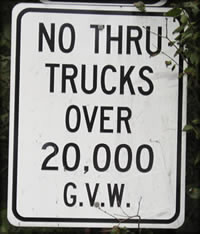
For permanent posting, better known as "No Thru Trucks", it is necessary to develop local rules which define the meaning and purpose of this sign. Usually, the purpose of these signs is to stop trucks from using this road as a shortcut or an alternate to avoiding traffic lights or built-up areas. It may be worth considering the creation of a "truck route" which is a positive step in providing clear direction to larger vehicles rather than a prohibitive motion that relies on enforcement which may or may not be readily available in a given municipality.
SIGN PLACEMENT TYPES Regulatory signs should be posted at each end of each road which the Town wants to restrict heavy vehicles. Where one road passes between two towns, it is highly recommended to work with the adjacent town to either
jointly post the entire road or not at all. This eliminates the possibility of a driver suddenly seeing posting signs at the town line and wondering if he should turn around or continue on while in possible violation
of
a local ordinance. The actual signs must be rectangular black lettering-on-white and be at least 24 by 30 inches.
Depending on the local ordinance wording, the sign could refer to "trucks" or "axles" or a
designated weight. If the sign refers to "Trucks", then your ordinance needs to define a "truck". does it mean only tractor trailers, or commercial vehicles over 26,000 lbs, or 2 or 3 axle delivery trucks, or simply a
Ford F-150 ? If the sign refers to "axles", that's rather definitive and can be counted easily on any truck. If the sign refers to "GVW" or a specific weight like "7 tons", then it should be referring to the registered
gross vehicle weight.
As a comment about using the word "Thru" on a sign, it should be clear that the intent is to regulate heavy trucks that are using this road more as a shortcut from one end to the other rather
than using it to access homes or a delivery or pickup point along the road.
MaineDOT Policy on Truck Restrictions on State and State Aid Highways
Acting on the recommendation of Carl A. Croce, Director, Bureau of Planning, and Bruce Ibarguen, Engineer of Traffic, the Commissioner approved the creation of a Department policy on July 13, 2005 that reaffirms State Rule 17-229, Chapter 104, entitled: Travel on State and State Aid Highways. This policy retains the concept that the MaineDOT has sole jurisdiction over restriction of commercial vehicles on state roads, and that municipalities may not prohibit commercial vehicles on state roads whether they are inside "urban compact" areas or not. However, this policy allows time-of-day restrictions of commercial vehicles, in very narrow circumstances, as long as there is substantial agreement between all affected parties, including neighborhoods, trucking firms, municipalities and other stakeholders.
Department Policy
Simply stated, no restrictions can be put on State or State Aid Highways whether these roads are in rural areas or "urban compact" areas, unless specifically restricted by the MaineDOT Commissioner.
This is affirmed in State Rule 17-229- 104:"It is the goal of the State of Maine, Department of Transportation that Maine's public highways be safe and efficient and contribute to the economic growth of the State and the well-being of its people. MaineDOT will make good faith efforts to have Maine's public highway network meet the social, economic, and environmental needs of the public. In addition, public highways are intended for the overall general use of the traveling public and for business, recreation, and overall access to areas across the State. Therefore, MaineDOT recognizes that there is an affirmative right for all individuals and entities, public and private, domestic or commercial, to travel on all State or State Aid highways in Maine. This right shall exist until the Commissioner of MDOT suspends or otherwise restricts any such traffic on any highway under MaineDOT jurisdiction."
However, there are growing issues relative to through commercial truck traffic on State and State Aid highways passing through residential areas. In certain cases, municipal officials are requesting some type of relief for homeowners who have chosen to live along these busy corridors. Because the requests usually respond to neither a severe safety issue nor the structural condition of a road or bridge, there is an option for municipalities to request time-of-day through truck restrictions on certain State roads from the MaineDOT. The following steps must be taken:
- The municipality must make a written request to the Department. Requests from an individual or groups of individuals will be referred back to the municipality.
- The request must be made following substantial public process and buy-in by all affected parties. Municipalities shall be encouraged to conduct neighborhood/stakeholder meetings before submitting a request.
- The request must not significantly affect traffic in municipalities other than the municipality which made the request.
- There is a reasonable alternate route for all traffic affected by the posting, as documented in part by the buy-in of affected commercial interests.
- The alternate routes do not create severe safety or congestion concerns.
- The municipality has passed a municipal traffic ordinance as described in Title 30A § 3009.
These restrictions may apply to all through commercial traffic over 26,001 pounds. It is understood that heavier local traffic (as opposed to through traffic), such as moving vans or fuel delivery trucks, should be allowed. However, because enforcement issues are largely local, and because the affected homeowners are entirely local, there is no statewide interest arising from this local choice of 26,001 pounds so a municipality may increase it if desired.
Basis for Authority
- 23 § 1 -- State Highway Law -- General Provisions
- 23 § 52 -- State Highway Law -- DOT -- General Powers and Duties
- 23 § 53 -- State Highway Law -- DOT -- Classification of Highways
- 23 § 1351 -- State Highway Law--Protection of Highways --Installation of signals, devices & signs
- 29A § 2395 -- Motor Vehicles -- Ways requiring special protection
- 30A § 3009 -- Municipalities & Counties -- Authority of municipal officers to enact ordinances
- 30A § 3001 -- Municipalities & Counties -- Ordinances -- Ordinance Power
- State of Maine Rule 17-229-104 -- Travel on State and State Aid Highways
- This Rule is a brief statement affirming the basic right of all highway users to travel on all State and State Aid highways in Maine.
Traffic Counts: Equipment Loan Program for Towns
The MaineDOT Traffic Engineering Division has a limited number of traffic counters available for free loan to Maine towns and cities. If your town wants to borrow a set, you can have it for up to 2 weeks and count
traffic on as many roads as you want to within that 2 week period. All counts have to be done on weekdays for a minimum of 24 consecutive hours.
If you’re interested, contact Aaron Buotte via e-mail or at 207-215-8103. You’ll have to come to Augusta to get it and Aaron will explain how/where/when the equipment is to be installed on your local roads. After the data is collected, his office will process the data and send you the finished “annual average daily traffic” counts (AADT’s) in an Excel spreadsheet.

